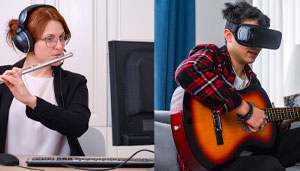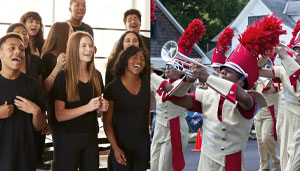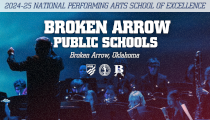Does Your Ensemble Suffer From Performancitis?
By Wesley D. Brewer on August 21, 2023 advocacy PrintThere you are in high school band, at your final concert of the year, a moment you and your peers have been working toward for several months. Between pieces, your conductor picks up the microphone to say a few words to the audience. We have all come to expect this talk. It allows time to reset the stage, to thank the audience for attending, and in some cases to provide some background information about the repertoire, similar to information that might be found in the program notes. Members of the ensemble who have finished preparing are now ready and listening intently to the speech as they nervously await the start of the next selection.
“The next piece we will play for you is the ‘First Suite in E-Flat’ by Gustav Holst. Gustav Holst is a prominent English composer who wrote several important pieces for the wind band including this one, but is probably most famous for his orchestral suite, ‘The Planets.’ The first movement of the First Suite is entitled Chaconne. For those of you in the audience who may not be familiar with this term, the musical form of the chaconne is a continuous variation, usually in triple meter and a major key. It is generally characterized by a short, repeating bass line or harmonic progression. The first movement opens with the repeating bass line in the low brass section, which is then repeated 16 times and taken through some very clever and interesting variations.”
The information shared is interesting, informative, and helps the audience to focus their listening. There is only one problem: the audience and the students in the ensemble are both hearing this information for the very first time.
Has this ever happened to you as a member of an ensemble? Have you ever thought silently, perhaps with a slight bit of irritation, “Well, that was really interesting information! Why didn’t you share that with us while we were preparing?!” I have certainly experienced this as a member of an ensemble, and more importantly I have been guilty of it as the conductor. If you have experienced this on either side of the podium, you might have been a hapless victim of a pandemic that has plagued ensemble-based music education for many years known as “performancitis.”
What is Performancitis? Can it be Cured?
In its most simple form, performancitis is a singular obsession with preparing for the next concert or contest, with repeating rhythms and correcting mistakes and intonation during every possible minute of every rehearsal to the detriment of most any other musical or educational activity. This disease is often triggered or enflamed by “overprogramming,” selecting music that is attractive for many reasons, but is actually beyond the real abilities of the musicians. We have all been there at one time or another. For a more in-depth look at this condition we turn to Robert Garofalo, a prominent conductor and author. As you read the following excerpt, I invite you to consider how relevant this feels today, either to your experiences in ensembles, or perhaps even in the classroom where you are the teacher/conductor:
The current state of school band performance in the United States is accurately reflected in a major research study by Jack Mercer. Mercer discovered that most high school band programs suffer from “performancitis”, that most [repertoire] is selected only by the needs of the next performance, and most band directors have no clear conception of what a band curriculum is, nor can they explain what they are trying to accomplish educationally with their students. Mercer concludes that band directors have been preoccupied with preparations for the next performance and have not taken time to develop comprehensive music curricula. As Mercer writes, “there are few carefully planned courses of study designed to teach students the fundamentals of music theory, introduce them systematically to the great composers, or assist them in comprehending the fascinating metamorphosis of musical form and style through the broad sweep of man’s history. Instead, our students concentrate on acquiring the technical competence necessary to play the [pieces] that we decide will make an interesting program for our next audience or will please our colleagues who will be judging the next contest.”
I have shared this passage many times with students enrolled in university music education courses. When I ask them to consider if this description feels current, most agree that this phenomenon is alive and well in schools around the United States, including many of the schools from which they graduated. They are often surprised that this excerpt is from the introduction to Garofalo’s book Blueprint for Band. It was published in 1976, more than forty years ago.
How far have we evolved as ensemble-based teachers in the last 40 years? How well do our daily lessons and rehearsals carry out the vision for the ensemble-based National Standards in music education, first presented in 1994 and then revised in 2014? How can we continue to advocate for being included as a “core” academic subject if students are not meeting basic learning outcomes for an education in music? Does taking time to discuss and connect music history, theory, and terminology related to the repertoire detract from performance preparation or add to it? These are difficult questions to be sure, but I believe that we have a collective professional obligation to confront them and to take steps toward curing “performancitis.”
Comprehensive Musicianship Through Performance as a Cure
Many journal articles and books outline detailed strategies for approaches that generally fall under the umbrella of “Comprehensive Musicianship through Performance” (CMP). To fully explore all the variations and ideas that have emerged over the last 60 years would be difficult in this space, but I will attempt to give a brief overview of the major projects and resources that exist and then provide some brief suggestions about where to begin implementing these ideas in your daily work.
The Comprehensive Musicianship Project in its modern form has roots in the Wisconsin Music Educators Association. A group of educators there continue to maintain a website (see references) that houses great resources for getting started with CMP. They also offer summer workshops where teachers collaborate to share strategies and develop teaching plans. You can find a document on their site that briefly outlines historical precedents that led to the formation of CMP including the Young Composers Project (1959), the Contemporary Musicianship Project (1963-1969), The Tanglewood Symposium (1967), the Manhattanville Project (1965-1970), and the Hawaii Comprehensive Musicianship Program (1967-1972). Several books over the years, like Blueprint for Band, have also been written to help teachers develop broader musical understanding in their ensemble-based classrooms. These have included texts like Teaching Musicianship in the High School Band (Labuta, 1972) and more recent books such as Shaping Sound Musicians (O’Toole, 2003) and Just Good Teaching: Comprehensive Musicianship in Theory and Practice (Sindberg, 2012).
I have used Shaping Sound Musicians as part of university courses for almost a decade now. My experience leading students through this work has shown me that young teachers generally find these approaches exciting, valuable, and eventually indispensable. Veteran teachers are sometimes quick to embrace these ideas, while others are slower or more skeptical. To be sure, developing CMP teaching plans and strategies does take more time in the initial planning stages. Repertoire selection has to happen much earlier and it is crucial to conduct a thorough analysis of the piece and be ready to discuss these analytical elements with students. It is important to develop a few key activities and assessments that will be used throughout the rehearsal process when the students are ready for them. However, many teachers find that the extra effort pays off three-fold when they are able to rehearse and speak about the piece with confidence and insight.
Embracing CMP can start in small doses. Perhaps you start with one piece each year, or if you are feeling more ambitious, maybe one piece per concert. Pieces with very clear historical connections are treasure troves for CMP approaches, including pieces that are based on folk song material or are representative of some important person or event (and there are of course many of these). What are the lyrics and meaning of the folk song source? From what culture is the song source? What other versions exist? Are there any recordings of the song? Is the song controversial for some reason?
The GIA book series “Teaching Music through Performance in Band” (and Orchestra, Jazz, and Choir, of course) provides helpful basic analyses and historical information for pieces that can give us a starting point and save valuable time. Consider making a form diagram for the piece and creating a handout for your students. Help them understand how the phrases add up to create each section of the form. Help them to understand the introduction and repetition of musical material that is used to bring unity and variety to the composition. As you move through the rehearsal process, use the terminology associated with the form to identify starting points for rehearsal such as “start one measure before the Development section” rather than the more simple and direct “start at measure 23.”
As you provide the agenda for the day’s rehearsal consider developing a list of “Take Out the Piece” statements that prompt students to solve the mystery of what piece will be rehearsed. For example, instead of saying, “take out the First Suite in E-Flat” you might say, “take out the piece in the key that is the relative major of C minor” or “take out the piece that begins in a medium triple meter.” If you have two such pieces in your folder that fit this description, even better. This prompts the students to notice that you are working on two pieces that both fit this description and that more information is needed to solve the mystery.
Take a look at the repertoire you are rehearsing right now. Start with the title of the piece and the name of the composer. Make it a goal that each student in the ensemble knows at least one important thing about each and hold them accountable for this learning. You can quickly generate any number of questions, activities, discussions, assignments, and assessment items with a little forethought and creativity:
- Why is the piece called this and what does that mean in this particular context?
- Is the composer alive or dead? What else did she compose?
- Where is the composer from? Can we contact her and ask questions?
- How is this piece typical or atypical of her compositions? Find a recording of one other of her pieces. Listen and write a paragraph describing the similarities and differences.
- Why is this a good piece for us to perform? What does it challenge us to do? How does it fit with the other music we are preparing?
- How is this piece similar to or different from the music we played for the last concert?
A common motto for Comprehensive Musicianship teachers is “Performing with Understanding.” Is it possible to play the Chaconne well without understanding the form and variations? Yes. But, imagine for a moment how the phrasing, expressive quality, and enjoyment of the rehearsals and performance might change when the students are asked to bring forth each variation of the repeated melodic figure and understand clearly where in the larger form they are at each turn. As Patricia O’Toole reminds us, we should want students to graduate from high school music having learned more about music than just 15 second clarinet parts. For many students, participation in high school ensembles will be the last formal education in music that they have. What do you want them to leave your classroom with?
References
Miles, R. B., Blocher, L., & Corporon, E. (Eds.). (2000). Teaching music through performance in band. Chicago, IL: GIA Publications.
Garofalo, R. J. (1983). Blueprint for band: A guide to teaching comprehensive musicianship through school band performance. Hal Leonard Corporation.
Labuta, J. A. (1997). Teaching musicianship in the high school band. Hal Leonard Corporation.
O' Toole, P. (2003). Shaping sound musicians: An innovative approach to teaching comprehensive musicianship through performance. Chicago, IL: GIA Publications.
Sindberg, L. (2012). Just good teaching: Comprehensive musicianship through performance (CMP) in theory and practice. R&L Education.
Wisconsin Music Educators Association. (2020, March 1). Comprehensive musicianship through performance. https://wmeamusic.org/cmp/
Wesley D. Brewer
This article first appeared in the Spring 2020 edition of the Oregon Music Educator. The Oregon Music Education Association promotes excellence in music education and serves the professional needs of its members. Check out the Oregon Music Educators Association here: (https://www.oregonmusic.org/)
Most Recent Articles







